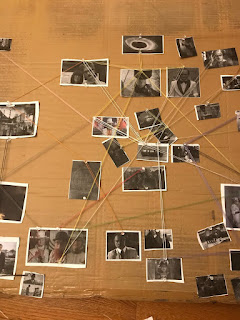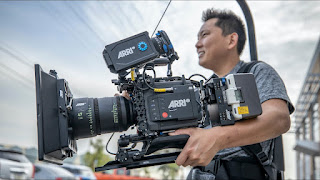Short Film Research: Thriller- Porcupine- A Prickly Predicament
Hello! We will now continue to examine the conventions we found within other short films in our genre. The next film will we be taking a look at is Porcupine by Clifford Miu, which we also acquired from the "Short of the Week" website.
Camera Angles, Movement, and Shots:
Within this short film, we saw a decent amount of camera shots being used. The most often utilized shots being the medium and medium long shots. Given that there is only one primary subject of the film, said shots capture her in the isolation of her own home. That, in turn, creates a more tense scenario once she realizes that she is in danger. Close-up shots are also used to create contrast within this short film, such as when the film opens and the shot transitions from a close-up of the sparklers children use on holidays to the cigarette a woman was smoking. Additionally, an over-the-shoulder shot was also used to place the focus on the main threat that the primary subject was facing, making her fade into the background as all attention went to who might be behind her front door.
When it came to camera angles, the short film primarily utilized eye-level shots since there were not really many other subject-to-subject interactions for different angles to be used to highlight the power dynamic between the two characters. That, in turn, allowed the viewers to better relate to and sympathize with the primary subject as she experienced the terrifying situation.
As for camera movements tracking and handheld shots were used together to make the scene feel more realistic. Doing so gave the audience the opportunity to feel as though they were piercing the event unfolding themselves in real-time, having the rush of adrenaline or sense of dread as the primary subject.
Mis-Én-Scene:
In this short film, the primary subject was dressed in a flannel overshirt, a regular graphic T-shirt, gray sweatpants, and a pair of socks. Moreover, she lacked makeup or a fancy hairstyle, all of which are befitting of her being alone (albeit for her baby) in the comfort and (what is supposed to be) the safety of her own home.
Most of the film is shot in dim and dark lighting, obscuring the vision of the viewers and having them focus on one particular aspect of the scene, which then allows for the sound design to create moments of heightened fear. The times when the film includes bright lighting are during flashbacks to memories the primary subject has with her now-deceased husband.
The primary subject seems to be in a forlorn state, which is to be expected given that she recently lost her husband. As the short film progresses, these feelings of sadness gradually evolve into emotions of fear and concern for the safety of her child as well as herself when a man tries to break into her home. Her terrified facial expressions and franticness over the phone with emergency services do a fantastic job of conveying that sense.
Props did help drive the plot along. For instance, the primary subject’s cell phone was used to call the authorities for advice on what to do about the person trying to forcibly enter her home, and her firearm was later used to kill the person trying to break into her humble abode. Other less noteworthy props include boxes, a baby bottle, and sunglasses.
The entire short film, except for flashbacks, is set within the home of the primary subject. The flashbacks take the subject to places including an outdoor party at night and the forest where she used to practice shooting with her husband when he was still alive.
Sound:
This short film had a number of diegetic sound effects, including the crackle of lightning, the sound of glass breaking (which was reversed and used to transition into a flashback), and the sound of a camera clicking. Even a voiceover was used when the primary subject began to regain memories of their girlfriend’s face. All of said sounds functioned to either further the plot in one way or another, or at the very least to set the tone of the film. When it came to the non-diegetic sounds, they mainly presented themselves in the form of dramatic music.
Editing:
This short film was not editing-heavy so to speak. It was comprised of mainly continuous, uninterrupted shots. The inclusion of flashbacks did allow for there to be cuts between the primary subject’s past memories. The briefness of said cuts does a great job of highlighting the fact that they are just quick thoughts that the subject is having as she goes about her daily duties. Blurring was added in some parts of the short for the purpose of creating a forced focal point for the audience. It is meant to serve as a reminder that just as the subject cannot escape the danger they are in, neither can the audience; they are visually trapped and pulled along for the ride.
Takeaways:
From this short film, my teammates and I came t the realization that we do not need to have multiple locations in order for our short film to be engaging. We could film the majority, if not all, of our short film in one location and still have it be captivating, so long as we make as our film as visually engaging as possible. We feel that this can be achieved by hiding clues in some of our scenes as to what is truly going on, as well as making the proper choices when it comes to our videography decisions. On the topic of camera-related techniques, we believe it may be interesting to use close-up shots of our own for the same purpose of creating a contrast between two separate ideas or even subjects because painting a parallel may help the audience better visualize certain messages we are attempting to convey.
We all thoroughly enjoyed this short film and found it to be an interesting moral dilemma to consider, so truly ask yourself, “what would you do(?)” (City High 1999).


Comments
Post a Comment